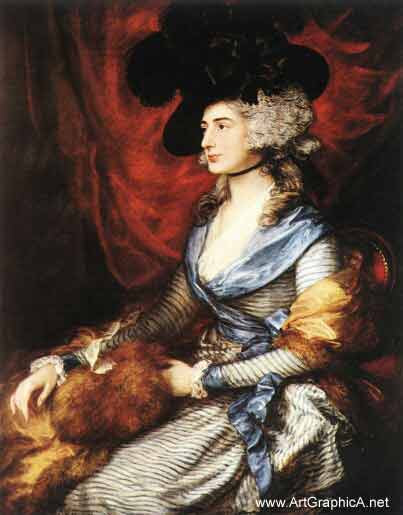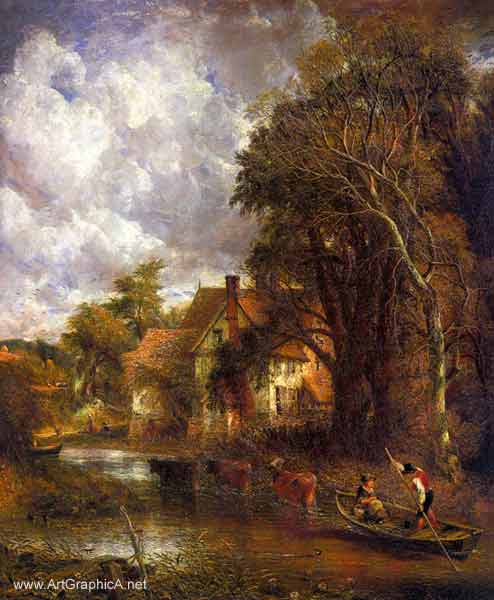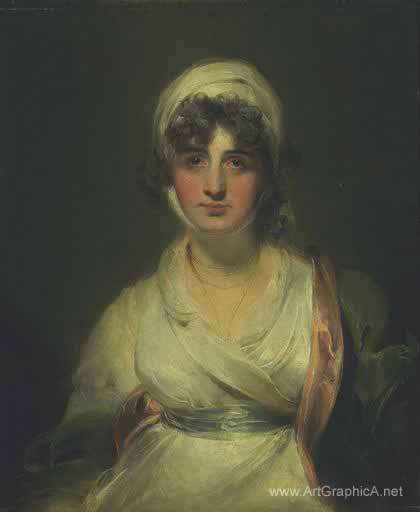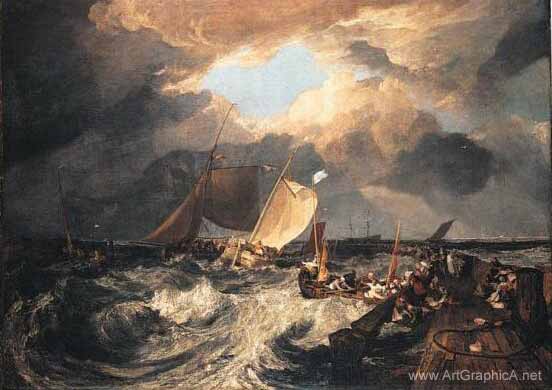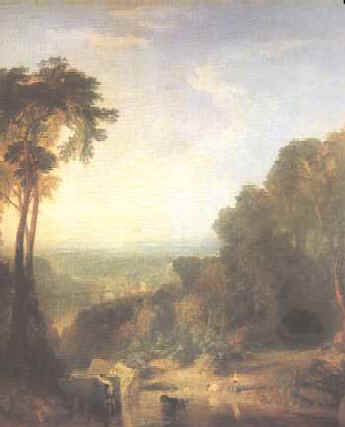COPYING THE OLD MASTERS |
||||||||||||||||
|
Page 08 / 09
OIL PAINTING BOOKCHAPTER IX THE FRENCH SCHOOLNICOLAS POUSSINTHE Bacchanalian pictures are inspired by Titian. Like the painters of the so-called " Eclectic " school, Poussin has selected from the Italian master ideas, forms, landscape setting, and colour. But although a good technician, very prolific, and at times more personal than in these pictures, he falls far short of his model. One loses interest in rechauffés of a bigger man's work. The French school is poorly seen at this gallery. Watteau, the finest product of French art, is not represented. An excursion to the Dulwich Gallery should be made to see him at his best, and there are a few choice pictures of his at the Wallace Collection, where Lancret is better seen than here. In his "Four Ages of Man" series, there is a charming panel, "Manhood," with the gracefully posed youths shooting arrows at a high mark ; but with the artificiality characteristic of the Frenchmen of the period, the amoureux spread around appear to be totally oblivious of the spent arrows which might well put an end to their amours. [217] Nor is Chardin to be judged by the two little pictures in these galleries. Claude is fine and clear in his stately and serene landscapes, but I prefer the "Dido building Carthage," by Turner, between two of them. What technically is so extraordinary in the Turner is the heated, sun-suffused atmosphere; which is attained by a scumble of warm colour across the sky, the hills, and the middle distance-a very interesting point to study. See behind this transparent scumble the boat, the builders, and incidents well defined in the first instance, and then fogged by this semi-opaque wash. A truly wonderful effect is here produced out of the endless resources of his genius. GREUZEMerimée tells us that " Greuze was fond of dead colouring in full impasto, which he glazed all over ; afterwards painting upon the glaze when it was dry, beginning with the lights and proceeding gradually to the shadows." Though somewhat artificial and over sweet, he has a tender grey in his flesh, which is often admirable. * * * * * * But now that in my poor way I have sought to show you how to extract and detach from a Work of art some of its constituents, you might try your hand unaided to seek a similar lesson, and profitable pleasure, on the remaining works in these galleries, or among others elsewhere. In any case, do not attempt more than about two rooms on any one day, on one occasion making a technical quest, on others, quite separately, notes on the linear construction of composition, the scale of figures to their setting, colour arrangements, and the massing of light and shade. It may even be instructive to join the crowd and look for subjective points of interest. And now let us make our way to the British section of these galleries. [219] CHAPTER X THE BRITISH SCHOOLSIR JOSHUA REYNOLDSTHE words written by Reynolds on the established method of his maturity have already been quoted. It was his habit at one period to jot down in Italian the colours, mediums, and processes of which he made use, in each successive portrait, notes which are to be found in Eastlake's " Materials." He was a great experimentalist, and methodically made these memoranda, eventually to confine himself to the combinations which furnished him with the best results. So we may take it that when he refers to his "established method," with it his best work was accomplished. Wax, I believe, is not mentioned at the time, but a solution of it, dissolved in spike oil or turpentine, was a favourite medium about which he told an amateur friend, asking him at the same time not to tell any one. The amateur tried the vehicle, and complained that it cracked. Reynolds's only answer was, "All good pictures crack." Now you will understand how it is that "The Age of Innocence " and many others that are of a thick [220] pasty consistence have cracked : but not all of them ; much depended on the nature of the other oils and varnishes used with the wax. There is always danger of pictures suffering that are done with a thick paste of colour entirely concealing the grain of the canvas. His heavy use of bitumen is also responsible for other fissures. Bitumen is liquefied when heated by the sun. A. story is told how a Reynolds picture with much bitumen, which had been exposed to the sun, was found with the eyes run down into the cheeks of the portrait. The only cure for this displacement was to leave the picture in the sun, and reverse it, till those features found a resting-place in their sockets again. Reynolds made many copies of the Venetian, Flemish, Dutch, and Spanish works, and embodied in his own painting what he admired in their methods ; and he was critical enough also to know what to avoid. His "gilded" final colouring is doubtless inspired by Titian and Rembrandt; his more silvery schemes, such as the " Two Gentlemen," by Velazquez. But for all his researches into the practices of other men, he is very personal, and there is no mistaking him for the masters from whom he did not disdain to learn. The "Portraits of Two Gentlemen" is one of his best works here, done on a canvas covered entirely with the grey of its background, an [223] idea evidently borrowed from Velazquez ; for, like the " Admiral Pulido-Pareja," the figures are superposed on its dry surface. In most modern portraits the background is painted wet with the head, but Sir Joshua managed to do more than a hundred in a year, and would find it facilitate matters to have some of his grounds nearly completed for him except for a final warming glaze. The more elaborate backgrounds were done by assistants, the master superintending and completing them while they were still wet, or by glazes and retouchings when dry. The breadth and oneness in these two heads is admirable, and there are no small accents to detract from their simplicity. The hair of the near man, the better of the two, is thinly suggested on the grey ground; the flesh and hands are first prepared with a cool monochrome, and then scumbled and glazed. The foreshortened hand against the black satin is a real pleasure to the craftsman, as is also the silveriness of the harmony. There is a frankness and freshness about this work rarely found in his pictures, many of which he juggled with, rubbing asphaltum and other glazes into them, so that now little light remains. Examples of this we have in a small lost profile at the National Gallery, " The Banished Lord," and in the " Snake in the Grass " with its heavy accidental shadows, in which the breast of the semi-nude figure is fine in colour and modelling. No doubt [224] by these means he achieved a rich colour-quality ; but they are dangerous, and more often than not leave destruction hi their wake. The "Admiral Keppel," painted with wax as a medium, has been so enriched, but is in good condition. The tone of the head against the splash of white on the neckcloth has the substance that such tonality gives. Its apparent brilliancy is heightened by the cast shadow on the crimson coat and the cloud of Antwerp blue for a background. It is finely drawn and boldly handled. There is little else but Indian red and black in the flesh of " Lord Heathfield," which is altogether a splendid performance, both in its modelling and telling character : a dignified old soldier. "The Countess of Albemarle" is but a slightly tinted monochrome like many of his portraits. No doubt the black tendency of the greys prompted him to force the colour in his other pictures. His black and blue under-painting helped the flesh greys, but when overdone destroyed the glow that Rubens held so dear. "The Age of Innocence" has all the charm of Reynolds's child pictures, and in spite of its fissures is simplicity itself. Only a strong concentrated light imparts such breadth, and only a "dilated" eye can seize it. If we have here the solidity that wax establishes, we must take the defects of the qualities of wax and be grateful. In " The Holy Family," cleanly done at first with a cold monochrome, we have a fine composition [225] effective in light and shade. But the head of the Virgin, otherwise beautiful, has about it a hard tinniness, for the edges are too clearly cut and not lost and found enough against its dark background. The pink of the dress is solidly painted into a glaze ; and on the child some dry draggings of colour are visible. "The Graces" do not belie their name. Here the great cast shadows are used so wisely that they save a composition which without them would be too markedly arranged. The quality of toned colour in sunlight is delightfully suggested. In the confused and poorly drawn " Lady Cockburn and her Children," the parrot against a fluted column is a colour passage of real beauty, a delicious harmony. "George IV. as Prince of Wales" is another frank and well-constructed head, and everything else by the master is worthy of the closest study. SIR JOSHUA REYNOLDSPORTRAITS OF TWO GENTLEMEN
National Gallery The bigly seen and broadly handled head of the man in black should help the student to realise and distinguish essentials from non-essentials in painting. L. PORTRAITS OF TWO GENTLEMEN. BY REYNOLDS CHAPTER XI THE BRITISH SCHOOL-continued GAINSBOROUGH, CONSTABLE, LAWRENCE, TURNER, AND OTHERSTHE charm of Gainsborough lies in his intense personality. Except those paintings which are directly inspired by him, there are few that resemble his style; and this individuality, combined with his faculty to seize sweet and elusive expression, make him one of the most lovable of our painters, in spite of seemingly puerile lapses-for of ten his drawing could not well be weaker, nor could his composition. But he could draw, and when he is careless about it and about his construction; he gives us at least something to compensate for their loss in all he did. The colour scheme of " Mrs. Siddons " first attracts us. There is an absence of positive shadow in the flesh. Let us see how it is done. The picture was evidently laid in in a cool monochrome, the flesh very sparingly glazed, and then accents, such as the black of the pupils, the nostril, the red of the mouth, a few streaks in the powdered hair, and the black velvet riband on the neck, just drawn with a small brush hi their respective places over the dry or nearly dry ground. [229] And, curiously enough, the effect is not hard, although a trifle thin. In Gainsborough's paintings there is rarely any decided impasto. Perhaps because of their thinness his pictures do not crack ; but they are often chalky in their whiteness. The blue and golden brown, with the black hat on the red setting, is a striking harmony ; and all these are but thinly stated. There was an old superstition that no picture was durable that was not loaded. Gainsborough settles that point for us, and we see that his meagre but clean white grounds uphold his light and freshness. In the "Parish Clerk" the exquisite hand on the book is fine in the quality of its shadow, and is in direct contrast to " Mrs. Siddons." The light and shade of this picture are fused together in wet state, and very subtly. The "Musidora" is somewhat patchy with its overglazed colour. "The Duke of Bedford's" head is brimful of nature. There is also a portrait of a dignified old man, and a tenderly coloured group of "The Baillie Family." The best technical lesson to be learnt from this artist's manner is the safeguarding of the fascinating freshness, and looseness of the sketch in the finished work. Why is the sketch often preferable to work completed from it? For one reason mainly : it is done in one painting, and therefore the light of the ground is not lost. [230] What, when our pictures are overloaded, are we to do to restore something of this looseness? Firstly, we should scrape away the heavily loaded passages with the " plush mat," and then, if necessary, scumble a little light opaque colour over them. When this is thoroughly dry, we have a new ground over which the paint should no longer suffer from the want of transparency. This process gives little trouble, and will regain for our work what over-labouring will have lost for us. Gainsborough's later landscapes are somewhat summary, dark, and scratchy. The earlier wood scene, " Village Cornard," more Dutch in feeling, has none of these faults ; it is juicy in colour, and more solidly handled. GAINSBOROUGH PORTRAIT OF MRS. SIDDONS
National Gallery A fine example of the lightness of handling so characteristic of the master's manner. LI. PORTRAIT OF MRS. SIDDONS. BY GAINSBOROUG ROMNEYThere are Romneys in our gallery that have their charm, but there is a flat emptiness about them. The flesh is rarely flesh for the want of greys, and his red shadows are monotonously mannered. It is hardly fair to judge him by examples that are in many respects not his best. CONSTABLEConstable broke new ground ; and so strong was the prejudice against the greenness of his work that he was requested to brown his pictures in the early days. For all that, he has had more [233] influence on modern art than perhaps any other painter. The " Flatford Mill," if seen alone, in spite of its hardness and lack of unity would appeal to lovers of light and nature, but by the side of his richer and more sparkling trio, next to be mentioned, it seems tame and uninspired. Such free use of the palette knife, as in his three notable canvases ("The Corn Field," "The Valley Farm," and "The Hay-Wain"), has always a taming effect on surrounding pictures that are painted without its aid, and, as with the craving for narcotics the doses of the reckless who are bitten with the craze, are gradually increased till the scintillations play havoc with a whole wall of neighbours. But there is a day of reckoning with these dust-traps, when all the glory is for ever departed. Constable could use his palette knife, but even with him the surfaces are sometimes a wee bit mechanical, as in the stag and tomb picture on the east wall, known as " The Cenotaph." "The Valley Farm" is finely dramatic. The accidental shadows and the concentrated light on the white house are conceived and executed with real mastery. CONSTABLE THE VALLEY FARM
National Gallery A sparkling richness due to the use of the palette knife. LII. THE VALLEY FARM. BY CONSTABLE CROMECrome had a singularly broad outlook. His " Mousehold Heath " and " Slate Quarries " claim consideration. The " Quarries " is done on a rough canvas similar to those on which Paolo Veronese [234] worked, and in touch recalls the great Venetian. Such is the effect of surface on style. SIR THOMAS LAWRENCEThe half-length of "Miss Fry" is well painted, if small in treatment. Larger in manner is " Mrs. Siddons," whose eyes, partly shaded by the overhanging fringe, are a fine study. The liquid play on the white draperies considerably enhances the attractions of this portrait, one of Lawrence's chef-d'œuvres. The unfinished " Portrait of the Princess Lieven" shows clearly his direct method. SIR THOMAS LAWRENCE PORTRAIT OF MRS. SIDDONS
National Gallery LIII. PORTRAIT OF MRS. SIDDONS. BY SIR THOMASS LAWRENCE HOPPNERThis artist is not seen to advantage in "The Countess of Oxford." The cast shadow is inevitable hi his silvery portraits. The whiteness in this is exaggerated; one longs for a little more warmth. RAEBURNThe lady in a white dress by Raeburn is undersized. The question of scale is a perennial subject of controversy. Portraits should not exceed, and be rather under life size, but only slightly so. There is a loss of dignity and a certain meanness in a portrait that is too large to be considered half [239] life size and is plainly intended to be full in scale. An irreverent friend calls it " monkey size." A really big head in nature suffers by much reduction in the portrait. Everything depends on the space around. An 8 1/2-inch man's head would be quite big enough for a small canvas, and may perhaps swim in a large area. JAMES WARDSome cattle by Ward in a picture entitled " Regent's Park in 1807," at which most Londoners will be surprised, are treated vigorously with a full brush in the lights. LANDSEERHis facility is extraordinary-quite a conjurer with his materials ; but for all its ease, the work is superficial rather than great. TURNERNow let us turn to the work of one of the greatest men of genius England has produced- perhaps the strongest landscape painter of any age. He may be equalled in some of his themes, but he has so many that his versatility appears truly phenomenal. Who ever painted the sea with all the depth and heaviness of its volumes, as in "The Calais Pier" [240] and "The Shipwreck"?-to say nothing of the dramatic intensity, of the whirl and boil of the waters, and of their light and shade. Mark, too, the juiciness of colour in his active life-giving little figures. Then think of his ingeniously constructive invention in the " Garden of Hesperides," with its mass of rock and its fearful dragon, and of the piecing together of innumerable studies into a homogeneous whole in the " Childe Harold's Pilgrimage, Italy," "The Bay of Baiæ," and many others. For technical soundness, which is not Turner's forte-for he often fights the impossible with impossible agents-note the freshness of one of the finest of all his productions, " Crossing the Brook." This, like his other " inventions," required careful thought in its preparation and, unlike his more impetuous efforts, remains fine in surface and colour. We shall see that the foliage in the middle distance has under it a substratum of solid white pigment, and we may surmise that the light passages throughout are done over a solid under-painting. The velvety tree against the sky is thick in its darks, and thinly drawn over the sky, and so its softness and roundness are felt. Look around and appreciate how varied are his resources and his ability to command his material in a hundred ways, to fit in with his mood and his wishes. J. M. W. TURNER CALAIS PIER
National Gallery Both this and the Shipwreck are great and dramatic compositions. The weight and the whirl of the water are superb. LIV. CALAIS PIER. BY J. M. W. TURNER J. M. W. TURNERCROSSING THE BROOK
National Gallery The fine preservation of this superb work, so rare with Turner s pictures, is undoubtedly due to careful preparation of the grounds. LV. CROSSING THE BROOK. BY J. M. W. TURNER [243] CHAPTER XII ON COPYINGYou may perhaps wonder that but scant allusion has been made to other than technical expression in the works reviewed. Firstly, there are innumerable and able writers who have dealt with the historical and intellectual aspects of these and kindred works. The most elegant litterateurs of the last century have spent their lives, not without effect, in such analyses of the arts, and to quote them here would confuse the issues and force me to overstep the necessary limits of a manual which, to be fully useful, should be portable. Our visit to these galleries is but a sequel to the preceding lessons, in which an attempt has been made to explain without elaboration two separate ways of working with an oil-painter's materials. In the galleries we have an opportunity of learning how, with the given processes and with variants on them, great results have been produced, or, I should say, appear to me to have been produced, by men who have mastered most of their possibilities. However imaginative or otherwise gifted the [244] painter may be, he has first of all to be a painter a sound craftsman. The knowledge of his medium, of expression and its capacities are his first essential requirement ; without it he is dumb-dumb as a thinker who is incapable of properly reducing his thoughts to words. To teach the alphabet of our art and a few useful expressions, is the primary object attempted. Advice has been given you during our visit to make copies of certain works. These should be begun after about a year's painting from the life ; and the experience gained in the making of such copies should be applied to the painting of succeeding studies from nature. The order in which they are done should be decided by your weaknesses, and works should be selected as correctives. If, for instance, you are able to deal with broad masses and fail in finish, copy such a work as Van Eyck's small head of a man with the red head-dress. If, on the other hand, you are too much tied down to your outline and are too timid to depart from it, or are inclined to over-model, try " The Age of Innocence," or the dark head in Reynolds's " Portraits of Two Gentlemen." They should certainly check any tendency to smallness. Later on you may attempt Van Dyck's " Van der Geest," and the small "Philip IV." by Velazquez. While painting the nude, first make a study of the two arms in " The Abduction of the Sabine Women " by Rubens, later " The Good Samaritan " by [245] Bassano, and last of all Rembrandt's "Woman Bathing." In every case select the picture which in your opinion, or, better still, in the opinion of others competent to advise you, is best calculated to counteract any obvious weakness to which your work leans. The student invariably follows his strength, which, until he is many-sided, is the last thing to do. You may neglect for a time what comes easiest to you, and turn to fortify the weaker links in the chain of your accomplishments. Do not lack the moral courage to exhibit your failings before your fellows, and do not let a childish vanity urge you on to a constant repetition of what you think your forte, or you will end in strengthening one set of muscles at the expense of all the others. Your performances will be lopsided and unequal. Value as nothing the praise of the incompetent, and value your studies in the making even less. AIDS TO COMPOSITIONYou will, of course, need to consider many things besides the manipulation of your materials-things to which, in the course of a little chat with you, references may occur. What I have just said with regard to a partiality in your painting study applies with even greater force to a neglect of composition. [246] You probably have, even if you are not conscious of it, some constructive ability, like the man who, on being asked if he could play the fiddle, replied that he didn't know, he'd never tried. You may not know. Anyhow, try ! I remember well that in a class of students whose work I supervised, and whose sketch compositions I criticised, there were some who mistrusted their capacity for artistic arrangement, and who with a little persuasion were induced to make an attempt in this direction. They gained in the course of tune much facility, and developed in some instances undoubted power. You may desire to make natural effects your chief aim, and if there lies your strength, by all means do ; but do not forget at the same time to make them decorative. They will be studies, and not pictures, if within the four corners of their frame they are ill-balanced. The first demand one makes of a work of art is that it be satisfactorily disposed, not necessarily on worn conventional lines, but that its pattern or " blot " be adjusted conformably to the shape and proportion of its setting, and that it obeys the laws of what is called decorative effect. These laws are very wide, for a good Japanese print is as decorative as a fine Titian, a complete Dutch genre picture, a Turner landscape, or a Velazquez portrait group. There are no actual limits to decorative laws ; you may even make new ones for yourself. An industrious striving to create [247] and record impressions you will find the best schooling. A knowledge of modelling in wax or clay is helpful in composing figures that are in action or that might be sculpturesquely interwoven. Nothing is more suggestive than some such plastic material. Lord Leighton, the grace of whose line is rarely equalled, modelled most of the groups for his classic compositions; and for flying or clinging draperies a fairly modelled clay figure, on which the material used has been previously dipped in a mixture of clay and water, and is arranged in folds which will remain in condition for an indefinite period, is hard to improve upon. Then there is a little secret of my own which I will now divulge to you. You have probably heard of a smoked plate- that is, a common white plate held over a lighted candle to blacken its surface. With the finger lights are touched out, and can be made often to suggest effective arrangements and fancies. It is a favourite pastime with students. But I think I have improved on this practice ; for china is fragile, to say nothing of the difficulty of storing piles of it ; the regrettable alternative is to efface what might one day prove a useful design. You should always keep your sketch compositions ; the best pictures are frequently done from sketches made many years before the final painting from them. With the assistance of an old friend I developed [248] this substitute for a smoked plate. We took a millboard about 20 by 16 inches-a convenient size-and covered it with Aspinall's enamel. When this dried, as it does in a day or so, we had an excellent surface for experiments. A wash of water-colour ivory black replaced the candle smoke, and with a wetted brush we amused ourselves making all sorts of fantasies. A few such prepared millboards are now to me indispensable, and I advise you to make some in the same way. They will greatly facilitate your management of line, grouping, and light and shade. In the same manner you can work in colour with water-colours, and you will find it the most fascinating thing possible. [249]
|
||||||||||||||||

